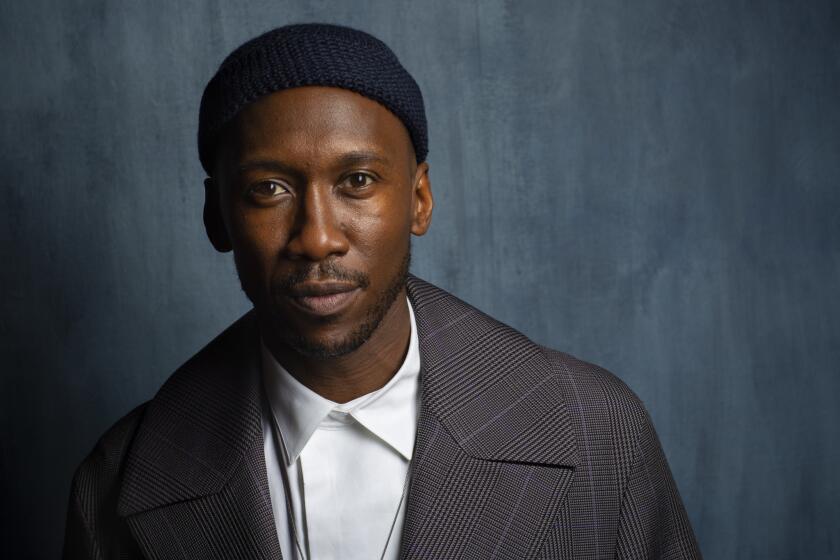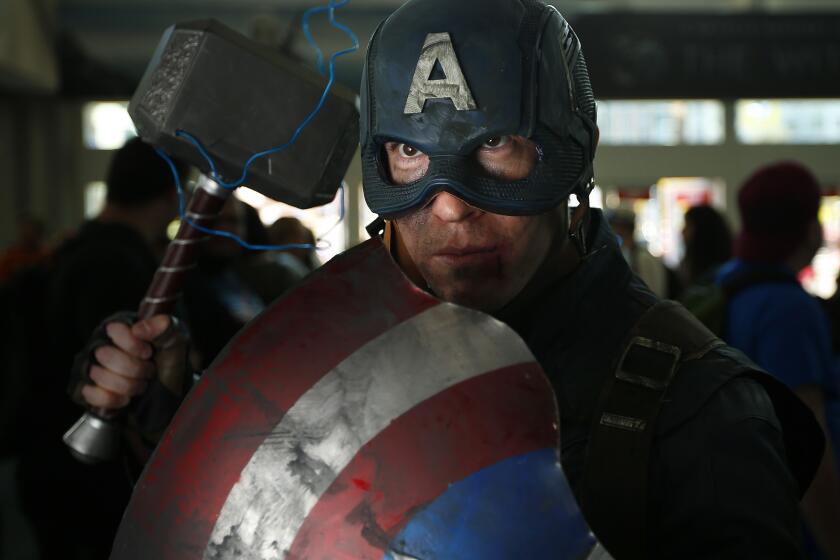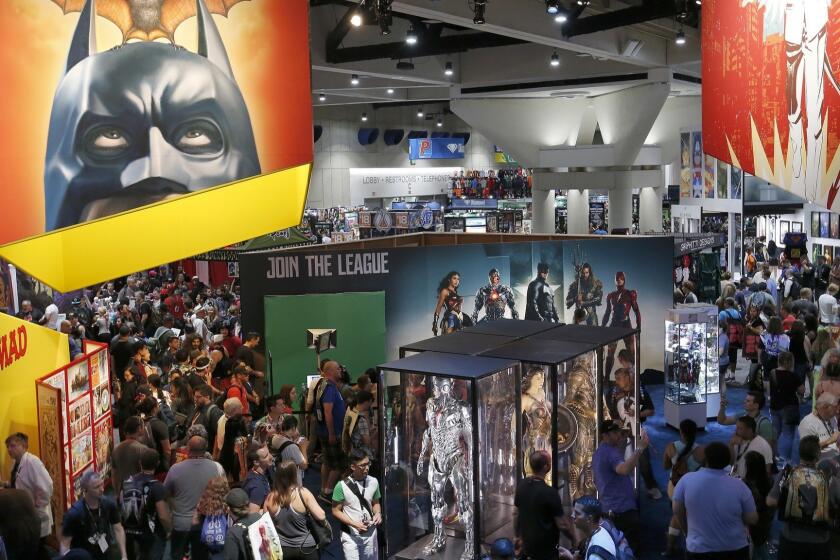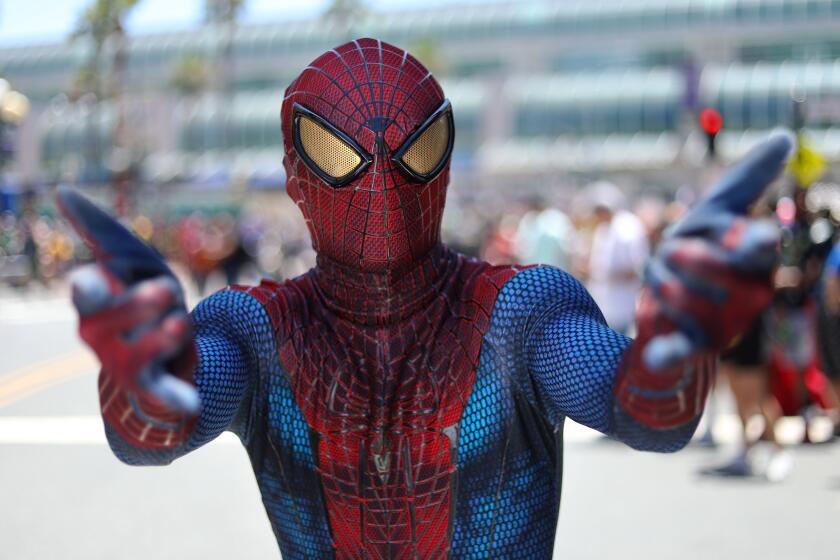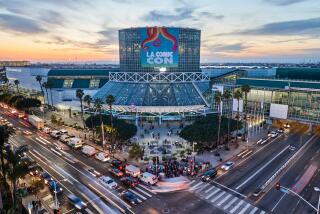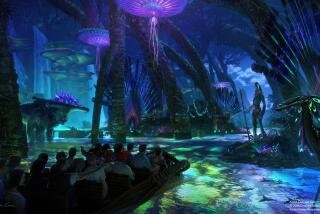At Comic-Con 2019, Marvel — not movies — is the main attraction
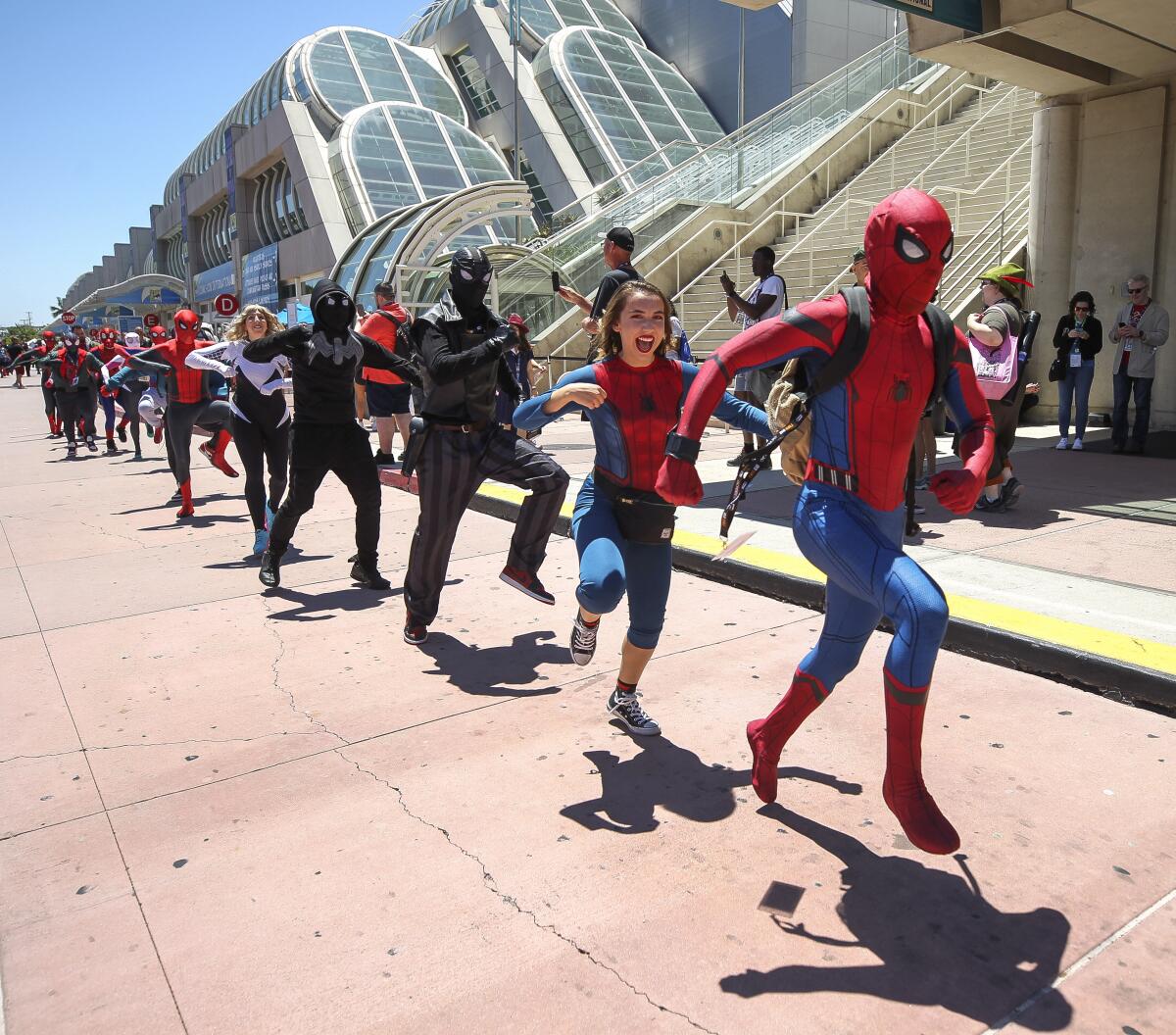
- Share via
SAN DIEGO — Excitement. Raucousness. Pandemonium.
As if the “rock concert” atmosphere that accompanied Marvel’s return to Comic-Con on Saturday wasn’t evidence enough of the franchise’s power — its news-making panel, held inside the San Diego Convention Center’s famed Hall H, drew such a large crowd that even journalists couldn’t make it inside — Disney co-chairman Alan Horn released a near-simultaneous statement announcing that Marvel’s “Avengers: Endgame” had surpassed “Avatar” as the highest-grossing film of all time, not adjusted for inflation.
“Marvel owns Comic-Con,” said “Single Parents” actor Jake Choi, who read about the highlights via texts from a friend who was at the panel. “I’m not just saying that because I’m on an ABC show.” (Disney is the corporate parent of both ABC and Marvel Entertainment.)
Marvel shared details on Black Widow, Thor, The Eternal and more at Comic-Con
Brand-friendly boasting aside, when it came to non-Marvel movies, the convention’s 50th edition felt downright sleepy. It threw into sharp relief an ongoing trend at Comic-Con and throughout the industry: the proliferation of scripted television, and of serialized film franchises that in many ways resemble television. The silver screen’s smaller footprint is likely the result of multiple factors, from Marvel’s dominance and the rise of streaming to the fact that most films come to such gatherings long before they hit cinemas. Whatever the reason, many fans met the movies’ reduced presence with a shrug.
At a double-header of panels for “The Walking Dead” and spinoff “Fear the Walking Dead,” AMC’s announcement of multiple additional TV series and three feature films within the franchise — the latter starring former “Walking Dead” lead Andrew Lincoln — elicited a muted response from fans and skepticism from the press. On Twitter, Hollywood Reporter television critic Daniel Fienberg tweeted that the “Walking Dead” movies, to be released by Universal Pictures and available only in theaters, constitute “a dramatic miscalculation” of what he’d be willing to spend to see the films: “That amount of money is ‘nothing.’”
By comparison, fans roared with cheers and applause for each of the 10 films and Disney+ series that Marvel President Kevin Feige announced as part of the studio’s upcoming fourth phase, an enthusiasm matched by multiple journalists covering the event.
Stephanie Wu, 29, a reporter for Chinese media outlet M Time, even cosplayed as Captain Marvel. She stood behind another reporter, dressed as a mash-up of Thanos and Spider-Man.
“This is my favorite female superhero character because, as you can see, everything’s covered up,” said Wu. “It’s practical, it makes sense. If you’re fighting, you’re covered up. I’ve been struggling to [find] a female character to dress up as for Comic-Con until Captain Marvel came along so I’m wearing this costume proudly.”
Though she’s been to Comic-Con only twice, Wu posited that movies aren’t abandoning the convention, but rather branching out beyond the convention floor.
See the best images from Day 1 of Comic-Con 2019 in San Diego, Calif.
“Instead of talking to fans [at panels], they’ve actually built things from the shows and the movies in experiential [activations],” said Wu, referring to the immersive branding opportunities that have become increasingly popular here and at other pop culture festivals in recent years. “This year, Comic-Con is like a huge carnival for me.” But these, too, included precious few movie tie-ins — “The Dark Knight,” “Pokémon Detective Pikachu,” “Shazam!” — against a raft of TV titles.
Besides the Marvel slate, the only other major movie to have a Hall H panel this year was “Terminator: Dark Fate.” Instead, suggesting an interest in gaining the attention of audiences through more intimate means, Warner Bros. promoted high-profile sequel “It: Chapter Two” by holding a ScareDiego event at the Spreckels Theater on the eve of the convention, a strategy it’s employed for three consecutive years. Plus, as Los Angeles resident Heather Horn, 30, pointed out, the studios’ penchant for holding one panel to introduce an entire slate of films can skew one’s impression of the absolute numbers.
“I feel like movies seem to get bundled into larger studio initiatives,” Horn said. “I did go to Hall H last year and I was there for the Warner Bros. panel. I mean, they talked and made a bunch of movie announcements, but it felt like it was part of a … larger Warner Bros. thing — ‘and here’s the movies, by the way.’”
Marvel’s splashy, star-studded announcement of its “phase 4” plans, beginning with Scarlett Johansson in“Black Widow” next spring and continuing through “Thor: Love and Thunder” with Natalie Portman in late 2021, also included “a bunch” of announcements — 10, to be exact. It’s a scale, and pace, that seemed tailor-made to grab the attention of the experienced Hall H audience, not to mention those awaiting news at home.
For 44-year-old Edward Pettis III, who’s been coming to Comic-Con for about 15 years, the emphasis on spectacle isn’t only Marvel’s doing.
The 50th year of San Diego Comic-Con is a reflection of how comics fandom has grown over the years. That’s not a bad thing.
“Having seen the rush, I can say that the market change came with the crossover of ‘Twilight,’” he said. “‘Twilight’ changed the culture quite a bit here and that was where you saw the rise of people camping out and the focus being more on movies as popular culture.”
But the overall lower number of films holds out the promise of a return to the convention’s roots. Pettis would like to see panels once again explore the craft of filmmaking, rather than serving as big-budget marketing for the studios. “If there was more of a focus on the technical aspects, as they used to have at the panels, that would more than compensate for the lack of exclusive content,” he said.
“Right now you’re getting a very impressive corporate style, but sometimes going back to the simpler effects and having to use your imagination [is better],” agreed Matthew Clemmons, 37, a safety officer and media advertiser from East L.A. “I love that about reading books and I would love to see more imagination brought back to the screen.”
Clemmons believes attendees are flippant about movies having a smaller footprint in Hall H because of the lack of originality on display there.
“There has been a sea change at Comic-Con but the main thing that we’ve been missing is original content,” he said. “They’ve all been remakes, re-imaginings or ‘I’m going to take this series and adapt it.’ And that’s the thing that upsets me the most … the fans deserve better. You’ve had 20 years, Disney. Come up with something new.”
Portraits of cosplayers from the 2019 Comic-Con International by San Diego Union-Tribune staff photographer K.C. Alfred.
Though the phenomenon may have intensified of late, the sometimes awkward relationship between Comic-Con and the movies dates back to the convention’s origins.
Most celebrities that came to the show in its earlier years “were strictly comic book,” recalled Bud Plant, founder of Bud’s Art Books, who exhibited at the first 48 Comic-Cons, beginning in the early 1970s.
“Once in a while, maybe the odd movie star [came], but they’d usually be stars of serials,” said Plant — referring to the multi-part movies, often geared toward children, shown at matinees in the 1940s and ’50s. “Back in those days, those were the big celebrities at a comic book show. It’d be whoever starred in the Captain Marvel serial or the Superman serial.”
Then in 1976, an upcoming movie that nobody had heard of came to Comic-Con to unveil a first look, along with some exclusive merchandise.
“They actually had a preview of ‘Star Wars’ at Comic-Con,” said Mike Towry, who co-founded San Diego Comic-Con as a teenager. “Of course, nobody knew that was going to be so big.”
“Star Wars” marketing director Charles Lippincott, comic book artist Howard Chaykin and story adapter Roy Thomas brought a presentation that year in hopes of building buzz. In addition to talking about the movie and showing some production stills, they brought a limited-run poster illustrated by Chaykin. (The poster now commands as much as $7,250.)
That year, the convention was held at the El Cortez Hotel and was attended by around 3,000 people. That’s a fraction of the crowd of 135,000 that convenes for Comic-Con these days, and less than half of the capacity of Hall H alone. Even so, the “Star Wars” panel wasn’t exactly standing room only.
Yes, even “Star Wars” had trouble filling a room before it became the franchise it is today — after all, a community of fans is easier to build around ongoing stories, such as comic books and TV shows.
Television has found a place at Comic-Con because like comics, TV shows unfurl their narratives episodically. Those with relationships to the existing characters and knowledge of past storylines gather at a convention to celebrate what they love about a particular series and await news of what’s to come. For many, it’s a love that grows over each additional installment.
“The longer narratives [of TV] fill a lot of the same niche that the weekly issues of a comic book used to fill, meaning there is a long arc,” said Oscar-winning director Guillermo del Toro, at this year’s convention with his new horror film, “Scary Stories to Tell in the Dark.” “On the other hand, the largest franchises already have that built-in massive audience that want to see the next installment of that ‘comic book’ — they want to see how it ends.”
Guillermo del Toro, a master of making on-screen monsters, unveiled his latest at Comic-Con 2019: the Jangly Man, from his upcoming film “Scary Stories to Tell in the Dark.”
In part, this explains why Marvel makes the splash that it does at Comic-Con. Its cinematic universe so far includes 23 interconnected films in three “phases,” released over the course of more than a decade — and it’s set to expand further. Coupled with the fact that its films and TV shows feature popular comic-book characters, Marvel has positioned itself to drum up excitement at Comic-Con like nothing brand new can.
Ultimately, whether hoping to nab a spot at the Marvel panel or eager for a glimpse of “Steven Universe,” “Star Trek: Picard,” or an array of YouTube stars, convention-goers acknowledged that Comic-Con’s TV-heavy programming is a reflection of the wider culture, in which the sheer volume of television dwarfs that of film. Asked about what she was most excited to see at this year’s edition, Marisol, a 25-year-old volunteer from Chula Vista who declined to give her last name, cited “What We Do in the Shadows” — another microcosm of an industry in flux.
“It was a movie that got made into a TV show,” she said. “Does that count?”
Times staff writers Ashley Lee and Jevon Phillips contributed to this report.
More to Read
Only good movies
Get the Indie Focus newsletter, Mark Olsen's weekly guide to the world of cinema.
You may occasionally receive promotional content from the Los Angeles Times.
